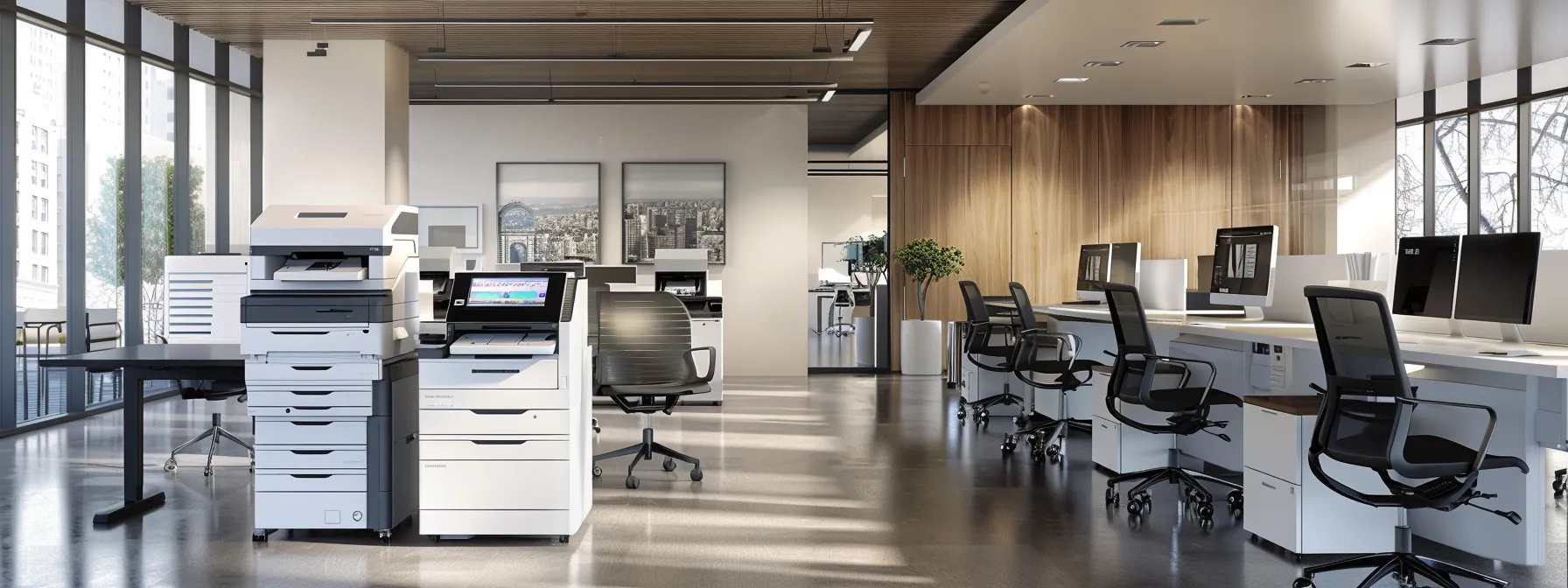Table Of Contents:
- Understanding Managed Print Services and Their Impact on Expenses
- Evaluating Your Current Printing Expenditures
- Implementing Strategies to Reduce Printing Costs With MPS
- Optimizing Your Printer Fleet for Efficiency
- Enhancing Workflow and Productivity With MPS
- Sustaining Cost Reductions Over Time
- Frequently Asked Questions
- Conclusion
Are you aware that the unmonitored costs of document production can devour up to 3% of an organization’s revenue? This eyebrow-raising statistic underscores the need for a strategic approach to manage printing expenses effectively, do you want to slash your printing expenses. The following content meticulously details how implementing Managed Print Services (MPS) can lead to significant cost savings, facilitate a more sustainable ink and paper usage, and bolster the efficiency of your help desk by automating maintenance tasks. Readers will uncover strategies for assessing current printing expenditures, optimizing their printer fleet, and enhancing workflows to sustain long-term savings. Dive into this guide to transform your business’s printing infrastructure into a streamlined, cost-efficient operation.
Understanding Managed Print Services and Their Impact on Expenses

As organizations seek to improve their bottom lines, Managed Print Services (MPS) emerge as a strategic approach to reducing printing costs. By carefully defining MPS, one can unveil its capacity to optimize a company’s document management system and infrastructure. The hidden expenses associated with conventional printing setups, including energy consumption and regulatory compliance, often go unnoticed. However, through the adoption of MPS, which integrates cloud computing advancements, businesses can realize not only direct cost savings but also environmental benefits. This subsection delves into real-life examples demonstrating how MPS has significantly lowered printing expenses for various organizations, underlining the tangible advantages of this modern business solution.
Defining Managed Print Services (MPS)
Managed Print Services (MPS) is a comprehensive approach designed to streamline an organization’s printing infrastructure, enhancing efficiency while minimizing waste and expenses. MPS encompasses assessing print needs, optimizing the number of printers, reducing toner consumption, and managing maintenance to reduce downtime and extend equipment longevity. By analyzing an enterprise’s print behavior, MPS providers tailor solutions to match specific requirements, aiming to transform printing from a burdensome cost center into a well-oiled component of business operations.
The effectiveness of Managed Print Services lies in its ability to address common pain points such as excess toner usage and unnecessary waste. A robust MPS strategy minimizes the environmental impact and reduces overall consumption by providing routine maintenance, intelligent device placement, and user education. This focused approach not only reduces waste but also decreases the energy required for printing processes, supporting the dual objectives of cost savings and sustainability:
The Hidden Costs of Traditional Printing
Traditional printing practices often lead to an erosion of an organization’s productivity and profitability. What frequently escapes notice are the less obvious expenses tethered to workflow inefficiencies, such as the time spent on troubleshooting printer issues or the financial burden of underutilized devices. Without a strategic fleet management approach, businesses encounter escalating costs due to untrackable consumables usage and mismanaged document processing which ultimately hampers workflow acceleration.
The absence of automation in conventional print systems amplifies the need for manual intervention, slowing down operations and diverting employee focus from core business activities. Moreover, organizations without a modern print infrastructure face amplified risks of security breaches, adding potential remediation expenses on top of already-high operational costs. A deeper understanding of these hidden costs stimulates business leaders to seek out MPS solutions designed to streamline document management and bolster secure information distribution channels.
Advantages of Adopting MPS
Adopting Managed Print Services (MPS) can significantly reduce the total cost of ownership for an organization’s print environment. Outsourcing printing management allows businesses to leverage expert resources and advanced analytics to monitor and optimize their print operations. This leads to a direct decrement in waste, streamlined workflows, and a more predictable monthly spend, alleviating the burden of costs that often go unchecked in traditional print setups.
Furthermore, the outsourcing element of MPS means companies can focus their internal resources on core business initiatives rather than print management. Managed services provide a comprehensive suite of capabilities from device optimization to improved document security, all of which contribute to lowering the possibility of unforeseen expenses. This strategic approach to managing print services elevates a company’s agility and responsiveness to change, allowing for adaptability in an ever-shifting business landscape.
Real-Life Examples of Cost Reduction Through MPS
In a case study involving a prominent legal firm, the adoption of Managed Print Services provided a singular example of the transformative power of MPS. By integrating Xerox’s advanced MPS solutions, the firm not only reduced its printer fleet by 35% but also achieved a 25% decrease in related costs. These savings were accomplished through smarter procurement practices, a more efficient equipment layout, and rigorous print audit systems that enhance accountability and control over how resources are used.
Another notable instance demonstrates the strategic benefit of MPS in managing risk and fostering digital transformation. An international retail chain faced significant challenges with their carbon footprint and document security risks. After MPS implementation, they witnessed a 30% reduction in print volume and a remarkable improvement in digital document workflows. This transition not only mitigated risks associated with paper-based data but also propelled the organization towards its digital transformation objectives, yielding a fortified stance against security threats and a greener operational model.
Evaluating Your Current Printing Expenditures

To effectively cut printing costs, organizations must first evaluate their current expenditures. Identifying direct and indirect costs, such as those hidden within inefficient print fleet management, is pivotal in forming a comprehensive MPS program. An analysis of print usage across departments furnishes a clear image of operational inefficiencies and sets the stage for establishing baseline metrics. These steps, critical in crafting a strategy that not only reigns in expenses but also promotes an environmentally friendly desk environment, will be the focus of subsequent sections, cracking open the door to significant savings and higher efficiency.
Identifying Direct and Indirect Costs
When dissecting printing costs, businesses must consider both direct and indirect expenses. Direct costs are readily apparent, such as consumables, maintenance contracts, and hardware. However, indirect costs like downtime due to equipment failure and lack of scalability can silently drain resources. A thorough audit helps identify these hidden drains while emphasizing the importance of digitization and authentication services that secure assets and streamline operations:
Specifically, a robust Managed Print Services (MPS) strategy addresses these expenditures by offering flexible contracts that accommodate changing business needs and promote cost-effective scalability. Considering long-term benefits, MPS propels businesses towards asset optimization and facilitates digitization, asserting control over both visible and opaque printing costs and securing organizational assets through robust authentication protocols.
Assessing Printer Fleet Efficiency
An initial assessment of printer fleet efficiency should begin with an analysis of current print jobs, giving special attention to the proportion of color printing, which often incurs higher costs than black-and-white outputs. By scrutinizing color usage patterns, organizations can implement policies that reserve color for essential documents only, thereby streamlining inventory needs and reducing the frequency and cost of toner replacements. Additionally, ensuring that devices are appropriately scaled to match workload demands can lead to significant improvements in operational efficiency.
Moreover, a review of the entire print environment must include an evaluation of data security, as printers and multifunction devices often store sensitive information. Implementing Managed Print Services with advanced security features mitigates the risk of data breaches, offering peace of mind and protecting the financial integrity of the business. Furthermore, conducting regular audits of printing equipment could reveal inefficiencies in inventory management, enabling a company to optimize its supply chain and reduce discrepancies in invoice reporting.
Analyzing Print Usage Across Departments
An astute evaluation of print usage across departments is crucial for pinpointing areas where efficiency can be optimized. Instituting a usage policy that limits non-essential printing or redirects it to more cost-effective machines can significantly decrease operational expenses. Moreover, incorporating mobile device printing can reduce the demand on traditional print hardware, potentially lessening machine-related costs and optimizing the existing fleet’s usage.
Focusing analysis on the print habits of each department often reveals varied needs and opportunities for tailored solutions. For instance, some teams may benefit from deploying higher-capacity devices in central locations to serve multiple users, which can help achieve a more favorable price per print ratio. This strategic placement aligned with usage patterns ensures that organizations avoid wasteful expenditure on underutilized printers or excess capacity:
Establishing Baseline Metrics for Improvement
Establishing baseline metrics is a critical first step towards enhancing the accessibility of print services for a workforce and maximizing return on investment. By leveraging predictive analytics, businesses can gain actionable insights into their current print operations, setting the stage for substantial improvements in cost-efficiency. Accurate baselines provide a clear starting point from which performance can be measured, thus establishing accountability and exposing areas ripe for optimization.
When evaluating baseline metrics, one must consider the impact of confidentiality protocols on the overall print environment. Proper oversight ensures that sensitive documents are handled securely, minimizing the risk of breaches that can erode trust and incur costly penalties. Through judicious analysis, organizations can strike an optimal balance between maintaining high levels of confidentiality and achieving desired reductions in printing expenditures.
Implementing Strategies to Reduce Printing Costs With MPS

Implementing targeted strategies to cut printing costs is crucial for businesses aiming to improve their bottom line. This section explores the steps to conduct a comprehensive print audit, customize Managed Print Services (MPS) for specific business needs, and train staff on efficient printing practices. It also examines the establishment of print policies and restrictions and the adoption of digital documents to reduce paper usage. These practices not only contribute to lowering energy consumption and ensuring better uptime but also strengthen a company’s reputation for environmental responsibility and operational standardization.
Conducting a Comprehensive Print Audit
Conducting a comprehensive print audit stands as the cornerstone in harnessing the full potential of managed print solutions. By meticulously assessing each aspect of a company’s print fleet, including usage, maintenance needs, and document management, organizations can identify costly inefficiencies and employ managed print services to refine processes. A thorough audit reveals how resources are currently allocated, thereby illuminating pathways to optimize printing practices and consequently reduce overhead costs.
Utilizing the expertise that Xerox MPS offers, a business can gain precise insights into its printing requirements and tailor its infrastructure to meet those needs effectively. The audit encompasses a detailed examination of print volumes, consumable longevity, and equipment performance to establish a clear baseline for continuous improvement. This process often results in a strategic reduction of the print fleet and improved document workflows, ensuring that managed print services not only save money but also enhance overall business efficiency.
Customizing MPS Solutions to Fit Business Needs
To effectively cut costs, businesses must tailor Managed Print Services (MPS) to align closely with their unique operational demands. An MPS provider conducts an in-depth review of the company’s print services environment to identify bespoke solutions that can reduce print volumes and manage the fleet more efficiently, ultimately leading to significant cost saving measures. This customized approach ensures that specific challenges a business may face, such as high color print usage or inefficient device distribution, are addressed directly through targeted strategies.
An organization’s commitment to cost reduction can be optimally supported by customizing MPS solutions to fit its exact needs. Deploying print services that account for the volume, nature, and frequency of print jobs ensures resources are concentrated where they yield the highest returns. The result is a tailored MPS strategy that not just cuts operational expenses but also enhances the streamlined functionality of the entire printing fleet, driving down costs and elevating efficiency.
Training Staff on Efficient Printing Practices
In the pursuit of reducing expenses within a managed print environment, educating staff on efficient print management practices is essential. Through a focused cost analysis, employees learn the financial impact of unnecessary printing and become cognizant of the true cost of equipment ownership. When staff are trained to recognize and utilize print resources prudently, organizations observe a marked decrease in frivolous usage, which contributes directly to a leaner operational budget.
The effectiveness of managed print services is significantly enhanced when individuals understand the role they play in a company’s cost-saving initiatives. Offering practical training sessions where staff members explore the features of current print equipment and learn to optimize their use can lead to improved print management and a culture of cost consciousness. This empowerment of employees equips them with the knowledge to make smart printing decisions, thereby driving down expenses related to print infrastructure.
Setting Up Print Policies and Restrictions
In the quest for innovation in cost reduction, setting up print policies and restrictions is an essential element of strategic planning. These policies can significantly curb printing expenses by enforcing rules around when and what employees can print. For example, limiting color printing to marketing materials not only economizes the use of expensive toner cartridges but also aligns with a company’s environmental footprint goals.
Access control measures are a defining feature of successful print policies, ensuring that resources are used judiciously across an organization. They empower management to keep track of print activities, thereby optimizing printer and toner cartridge use. The culmination of these efforts not only reduces overhead but also supports a sustainable office culture:
- Establishing print quotas per department to monitor and control volume.
- Implementing mandatory duplex printing to halve paper usage.
- Restricting color prints to essential documents using access control settings.
Leveraging Digital Documents to Cut Paper Usage
Transitioning to digital document management is not only environmentally astute but also an effective strategy for cutting paper usage and associated costs. By relying on secure digital backups and streamlined online troubleshooting processes, businesses reduce the need for physical copies, which in turn lowers overheads substantially. Contact Kraft Business Systems to explore Managed Cybersecurity Services that protect your digital assets, ensuring your transition to a paperless environment is as safe as it is cost-efficient.
Kraft Business Systems excels in aiding companies to implement digitization strategies, embracing technologies that reduce the reliance on paper. Visit Kraft Business Systems for guidance in deploying modern solutions that complement your company’s move towards digital documents, leading to cost savings and increased efficiency. Through practical examples such as adopting e-signatures and digital workflow approvals, organizations can observe a significant reduction in print volume:
- Employing e-signatures to minimize the necessity for physical contracts.
- Integrating digital workflow approvals to expedite processes without printing.
- Utilizing cloud-based document storage to improve accessibility and reduce onsite storage needs.
Optimizing Your Printer Fleet for Efficiency

Optimizing your printer fleet embodies a comprehensive approach pivotal to slashing printing expenses and is integral to Managed Print Services (MPS). A strategic consolidation of devices into multifunction printers coupled with upgrading to energy-efficient equipment can significantly cut costs. Furthermore, positioning printers tactically within the office space reduces redundancy and enhances convenience. By negotiating better supply contracts, organizations leverage MPS to secure superior deals on Office Technology Products. This section will explore actionable steps to achieve these efficiencies. For more insights, consider reading about managing your printer fleet.
Consolidating Devices to Multifunction Printers
Consolidating isolated printers into multifunction devices presents a strategic move that can remarkably streamline operations and decrease costs for businesses. By integrating print, scan, copy, and fax capabilities, multifunction printers reduce the need for multiple machines, culminating in lower energy consumption and space utilization. The compact footprint of such devices paired with streamlined maintenance requirements illustrates a practical example of how companies effectively manage their printer fleet with notable cost efficiency.
Companies looking to improve their managed print services often find that multifunction printers offer not only a reduction in initial capital investment but also a decluttered office environment. Such devices facilitate a centralized printing approach, making it easier for IT teams to manage and for staff to access, serving as a singular, capable hub for all document-related tasks. This approach exemplifies how the right technology choices can address the operational costs of printing while bolstering workplace efficiency.
Upgrading to Energy-Efficient Equipment
Transitioning to energy-efficient equipment is a prudent step for businesses aiming to reduce printing costs and support sustainability efforts. Energy-efficient printers draw less power and thus, contribute to lower electricity bills, a feature particularly beneficial for organizations with extensive print needs. Crafted with the latest technology, these printers often provide superior performance, which translates into faster, more reliable printing and fewer work disruptions.
One notable aspect of integrating energy-efficient equipment is the potential eligibility for tax incentives or rebates, an opportunity that should not be overlooked by cost-conscious business owners. By investing in printers with environmental certifications like ENERGY STAR, companies not only manifest their commitment to eco-friendly practices but may also reap financial rewards. These advanced devices typically exhibit extended lifespans and require less frequent maintenance, culminating in a wise long-term investment that aligns with the ethos of Managed Print Services (MPS).
Strategic Placement of Printers to Reduce Redundancy
Strategic placement of printers can drastically reduce redundancy, leading to not only decreased hardware costs but also reduced maintenance expenditures. By conducting thorough evaluations of printing needs across all departments, enterprises ensure that each printer serves a strategic role, positioned to serve multiple users efficiently. This eliminates the unnecessary proliferation of printers, carving a path toward a leaner, more cost-effective print environment.
Optimal printer deployment is informed by usage patterns: devices placed in accessible yet centralized locations minimize underuse or overuse, enabling more evenly distributed wear and tear. This conscious arrangement prevents the common pitfalls of an unoptimized print infrastructure and is a vital component of Managed Print Services (MPS) designed to lower operational costs:
- Neighborhood printers situated for team access pertinent to high-demand areas.
- Personal printers reserved for roles requiring confidential outputs or specialized tasks.
- Fleet scalability that aligns with organizational growth, avoiding premature investment in surplus hardware.
Negotiating Better Supply Contracts Through MPS
Engaging Managed Print Services (MPS) enables businesses to negotiate better supply contracts for printers, ensuring optimal cost-efficiency. Through comprehensive MPS agreements, organizations benefit from reduced consumable prices and maintenance services at predetermined rates, allowing for streamlined budgeting and expense management.
These supply contracts, facilitated by MPS providers such as Kraft Business Systems, typically offer scalable solutions that adjust to changing business demands, providing not only immediate savings but also long-term financial foresight. Clients gain the advantage of expert negotiation, which can include flexible terms and volume discounts, directly impacting the bottom line favorably.
Enhancing Workflow and Productivity With MPS

Managed Print Services (MPS) extend beyond simple cost cuts to fundamentally enhance workflow and boost productivity. Streamlining document management processes, implementing secure printing protocols, automating routine tasks, and embracing cloud services enable remote access, thus refining operational efficiencies. Each upcoming section will unpack these powerful tools, illustrating their significant role in sculpting a modern, cost-efficient print environment.
Streamlining Document Management Processes
Streamlining document management processes with Managed Print Services (MPS) methodically transforms overwhelming paper trails into efficient digital workflows. Through MPS, organizations can digitize document handling, reducing the time and costs associated with storing, searching, and securing physical files. This modernization is a key strategy for businesses seeking to cut printing expenses and simultaneously fortify their operations against data loss or breaches.
Managed Print Services providers offer expertise in automating routine tasks within the document lifecycle, enabling employees to focus on high-value work instead of mundane paperwork. With advanced scanning solutions and intelligent document recognition, MPS facilitates the swift conversion of documents into accessible digital formats. This ensures not only cost savings but also expedites decision-making and enhances service delivery, directly impacting an organization’s bottom line and productivity.
Implementing Secure Printing Options
Implementing secure printing options through Managed Print Services (MPS) offers businesses the dual advantage of curtailing unnecessary print-related expenses and reinforcing data protection. With features such as pull printing and user authentication, MPS ensures that documents are released only when authorized users are present, thereby reducing the risk of information breaches and controlling access to sensitive materials.
The strategic integration of secure printing protocols within MPS also streamlines workflow, eliminating wasted prints and contributing to a more productive environment. As a result, organizations benefit from a decrease in redundant costs while fortifying their print ecosystem against potential security threats, ultimately enhancing operational efficiency and protecting their bottom line.
Automating Routine Print Tasks
Automating routine print tasks is a cornerstone of Managed Print Services (MPS), directly contributing to reducing overhead and bolstering productivity. By implementing software that automates tasks such as batch printing, document sorting, and printer queue management, businesses streamline their operations and minimize manual intervention. This focus on automation enhances efficiency and allows employees to dedicate time to more strategic tasks, thereby lowering printing costs and improving workflow dynamics.
Empowering a workforce with tools for automated print management offers immediate and tangible benefits: reduced waste due to uncollected prints, faster turnaround times, and enhanced accuracy. Such automation within MPS leads to consistent processes and reliable outcomes, diminishing the potential for human error and the overuse of printing resources, which aligns with the goal of expense reduction:
Integrating Cloud Services for Remote Access
Integrating cloud services for remote access stands as a transformative step in managing print services, catering to the evolving needs of a mobile workforce. By allowing employees to print from anywhere, cloud solutions reduce the dependency on office hardware, which can lead to lower costs and improved workflow efficiency. Companies that implement these services benefit from a scalable print environment capable of adapting to fluctuating demand, underscoring the importance of flexibility in today’s business landscape.
The transition towards cloud-based print management is facilitated by discerning the proper integration techniques that ensure ease and security: aligning with enterprise content management systems, incorporating secure print release functionalities, and leveraging cloud storage for immediate access to print jobs. With these enhancements, businesses streamline their document workflow processes and support a remote work model, fulfilling the need to accommodate a distributed workforce without compromising print service quality or security.
Sustaining Cost Reductions Over Time

Ensuring enduring cost efficiencies in a managed print environment demands meticulous oversight and regular strategy refinement. This subsection introduces methods to leverage print usage analytics to monitor performance, iterative evaluations of Managed Print Services (MPS) strategies to maintain alignment with business objectives, adoption of recent technological improvements for optimal functionality, and routine calculations of Return on Investment (ROI) to quantify the tangible value derived from MPS implementations. These approaches form the cornerstone to securing lasting reductions in printing expenses.
Monitoring Print Usage With Analytics
Utilizing analytics in monitoring print usage stands as a core strategy for Managed Print Services (MPS), offering organizations the data-driven insights necessary to sustain cost reductions. By tracking printing activities across various departments and devices, businesses can pinpoint high-consumption areas and adjust policies effectively, maintaining a streamlined print environment and avoiding the resurgence of unnecessary expenses.
The application of analytics within MPS enables enterprises to observe user behavior, gather performance data, and identify trends over time. This information becomes instrumental in developing proactive measures and cost-saving decisions, ensuring that investments in print management yield consistent, long-term financial benefits.
Regularly Reviewing and Adjusting MPS Strategies
Regular assessments and revisions of Managed Print Services (MPS) strategies are essential for businesses aiming to sustain cost efficiency in their print operations. Firms can ensure that their MPS solutions continue to align with changing business goals and market conditions by initiating periodic strategy reviews. These adjustments may include scaling services to meet evolving workload demands or integrating newer technologies to streamline processes.
To illustrate, a corporation may find that its print volume needs fluctuate seasonally or as a result of growth: a need for more robust analytics to optimize print environments and a shift towards digital document management to reduce dependency on printing. In response, a Managed Print Services provider can adjust the strategy accordingly:
- Analyze seasonal print trends to forecast demand and adjust fleet capacity.
- Enhance print analytics for deeper insights into cost-saving opportunities.
- Shift towards digital solutions to reduce print volume and costs further.
Such proactive adjustments not only enforce cost controls but also promote a dynamic, responsive approach to print management. Ultimately, by regularly reviewing and adjusting their MPS strategies, businesses maintain a competitive edge and a sustainable reduction in printing expenses.
Keeping Up With Technological Advances in Printing
Adapting to technological advancements in the printing industry is pivotal for organizations seeking sustainable cost reductions through Managed Print Services (MPS). Continuous investment in the latest printing technologies can lead to significant savings; modern printers with enhanced capabilities often deliver higher efficiency and lower energy consumption, resulting in reduced overhead. Such advancements also offer upgraded security features, crucial for protecting sensitive business information and minimizing the risk of costly data breaches.
The value of staying current with technology extends to software improvements that allow for better device management and maintenance. For example, predictive maintenance tools can preemptively identify issues with printing equipment, preventing downtime and the associated loss of productivity and cost. The intelligent software enables businesses to refine their MPS strategy in line with technological progress, ensuring optimal print environment performance:
Measuring Return on Investment (ROI) Periodically
Periodic measurement of Return on Investment (ROI) is an instrumental process for businesses engaging in Managed Print Services (MPS) to ensure constant awareness of financial gains relative to MPS-related expenditures. By frequently calculating ROI, organizations can precisely track the efficacy of MPS in driving down printing expenses, thus validating the investment and guiding future decision-making. Regular ROI assessments enable an organization to maintain fiscal discipline and ensure that the cost reductions achieved through MPS persist over time.
For a company to accurately gauge the success of its Managed Print Services, implementing a routine schedule for measuring ROI is essential: this includes tracking reductions in consumable costs, monitoring maintenance savings, and assessing the impact of improved productivity on overall business performance. Such diligent evaluations illuminate whether MPS strategies are delivering the expected value, determining if adjustments are necessary to ensure continued cost optimization and operational improvement:
Frequently Asked Questions
What exactly are managed print services (MPS)?
Managed print services (MPS) are comprehensive solutions provided by external providers to optimize and manage a company's document output. The services encompass monitoring, maintaining, and supplying printers and copiers, aiming to improve productivity and reduce costs.
By outsourcing to MPS providers, businesses can streamline their printing operations, receiving tailored support for printer maintenance, consumable replenishment, and improved document security, all under predictable budgeting frameworks.
How can MPS lead to significant savings on printing costs?
Managed Print Services (MPS) streamline your printing operations by analyzing usage and optimizing your print environment. This strategic approach results in lower paper and toner consumption, reducing printing costs and waste.
Furthermore, MPS provides regular maintenance which extends the lifespan of your devices, ensuring cost-effective and efficient printing solutions. By consolidating printer fleets and implementing rules-based printing, additional savings are secured.
What are the first steps to take when assessing my current print expenses?
To assess your current print expenses, begin by analyzing your budget for printing. Examine recent invoices from your office equipment provider, noting the costs associated with acquiring, operating, and maintaining printers and copiers.
Next, evaluate the usage of your devices. Track the volume of printed materials and supplies consumption, such as ink and paper, to identify patterns and potential areas for cost reduction.
In what ways can optimizing my printer fleet boost efficiency?
Printer fleet optimization critically enhances office productivity by streamlining document workflows. Accurate tracking of printer usage data advises on the consolidation of underutilized resources, saving time and reducing operational costs.
Efficiency increases with optimized printer fleets through automated supply replenishment and maintenance alerts. This minimizes downtime and ensures continuous, quality output for a business’s document needs.
Does integrating MPS improve overall office workflow and productivity?
Managed Print Services (MPS) streamline document management, minimizing machine downtime and optimizing device utilization. This consolidation improves workflow efficiency, allowing staff to focus on core business tasks rather than printer-related issues.
Furthermore, MPS enhances productivity by automating supply replenishment and providing timely maintenance, which reduces the frequency of operational disruptions. Businesses can expect cost savings and a boosted bottom line as a result of more effective resource allocation.
Conclusion
Managed Print Services (MPS) offer a critical pathway for businesses to slash printing expenses and streamline operations. By adopting MPS strategies, companies can achieve substantial cost savings through enhanced printing efficiency, intelligent device management, and reduced paper and energy usage. Regular audits and tailored MPS solutions align with business objectives and embrace technological advancements, securing ongoing fiscal benefits. Ultimately, MPS represents a strategic investment in operational excellence that delivers measurable reductions in printing expenses and a boost to overall productivity.






